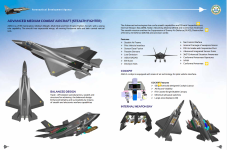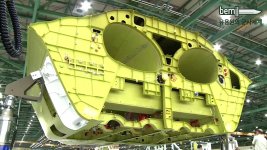I think once we dropped out of FGFA program, the requirements of AMCA project changed too. Now air superiority is a core requirement for the project.
One would assume. But the changes we made to AMCA (like going from 20 to 25-ton MTOW) appear more in line with an increase in range/endurance rather than aimed at air superiority. But the internal weapon stations haven't increased & the planned powerplant class hasn't changed (we always intended on F414 from the start), so the kinematics are actually worse than before - unless it gets the next-gen engine.
In the form in which it passed CDR (with F414), it is really no different to the KF-21 in terms of performance or size. And the KF-21 is by no means an air superiority plane - that should answer your doubts.
Due to lack of a dedicated 5th gen air superiority platform, the AMCA would definitely be
asked to do that role, but I'm not seeing how, if at all, we made it any better at that role than before just by virtue of airframe design.
Plus KAAN being bigger than F-22
It's just bigger in terms of overall size. But F-22 is still heavier & carries more internal weapons (8x compared to KAAN's 6x).
...doesn't mean it will achieve Air Superiority better until they develop those next-gen engines.
Better than what? F-22? No way - the Raptor has over half a century worth of aerospace know-how behind it whereas the Turks have just begun their journey. Not to mention even on paper the F-22 is still a better plane in terms of kinematics than the KAAN.
But better than AMCA in air superiority? Even with the existing F110 engines, KAAN still enjoys a considerably better TWR than the AMCA + it carries 6x air to air weapons internally as opposed to AMCA's 4x.
So on paper, yes KAAN is a better air superiority fighter than AMCA.
The one aspect where I suspect AMCA could hold the advantage is with regard to the radar & avionics. We have had more experience in developing & operationalizing AESAs of our own design than the Turks, and that will translate into a potentially better, but certainly more refined/efficient FCR for the AMCA.
KF-21 would be inducted quickly than AMCA, true; but if our project catches speed then we won't be that behind it,
If my bicycle had a motor, it would be a motorcycle.

Jokes aside, I'm not concerned about 'catching up' with KF21 in terms of who does something first - I'm saying that (barring AMCA's next-gen engine program), the two platforms in their definitive state will be pretty similar in terms of capability.
Either way, South Korea isn't our adversary so that doesn't matter. China is our adversary, and they already have over a hundred stealth fighters in service, and several hundred more to come. Even Pakistan will be inducting its first FC-31 into operational service much before our AMCA even achieves IOC.
That's who we are competing with. And we're already well behind.









